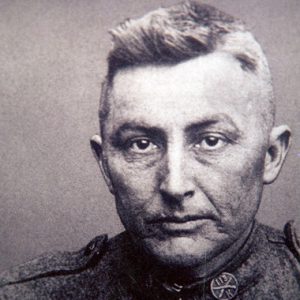calsfoundation@cals.org
Herman Davis (1888–1923)
Herman Davis was an outstanding marksman who distinguished himself in the U.S. Army during World War I. General John J. Pershing listed Davis fourth on a list of the greatest heroes of World War I.
Herman Davis was born on January 3, 1888, at Big Lake Island, which later became Manila (Mississippi County), the son of Jeff and Mary Ann Vance Davis. The family operated a country store and supplemented its meager income with hunting, fishing, and farming. Davis quit school after the fourth grade to help support the family. He grew up in the woods and became a hunting guide at an early age, thought to be in his teens. Davis was an accurate shot and in the period before federal game laws set game limits, killing as many as 400 ducks per day with his cousin, James Davis. The ducks were sold and shipped by the hunters to northern markets, where the hunters earned one dollar per duck.
Although initially rejected for military service because of his 5’3″ frame, Davis was eventually drafted and was inducted into the Army on March 4, 1918, in Blytheville (Mississippi County). He was sent to Camp Pike for training and then sailed for France on June 15, 1918, as a member of Company I, 113th Infantry Regiment, Twenty-ninth Division. Davis had been married, but his wife left him and their son. When Davis was drafted, his mother took care of the child.
Davis was a scout and was required to go out in advance of his company. Many times, he encountered poison gas. On patrol in a valley near Verdun, his platoon came under fire from a German machine gun situated on a hill on Molleville Farm. Davis crawled within fifty yards of the gun and killed four enemy gunners. In other engagements, Davis was credited for killing fifteen enemy gunners in a machine gun nest and eleven enemy soldiers climbing out of a dugout. Another time, a group of enemy soldiers were trying to set up a machine gun in an area they thought was out of range of American troops. Davis shot and killed five of the enemy soldiers. He reportedly stated that 1,000 yards was “just good shootin’ distance.” Davis was honorably discharged from the Army on May 29, 1919.
The United States awarded Davis the Distinguished Service Cross, and France presented him with the Croix de Guerre with Palm, the Croix de Guerre with Gilt Star, and the French Medaille Militaire.
Davis returned to Manila and began work at the Big Lake Hunting Club. He told no one about his war record or his exposure to poison gas. His friends and family learned of his heroism only after Pershing’s list was published. At their insistence, he took the medals from a tackle box and reluctantly showed them.
By mid-1922, Davis’s health began to fail. His exposure to poison gas during the war caused him to develop tuberculosis, and he eventually became too weak to work. Members of the Dud Cason American Legion Post in Blytheville transported him to the Veteran’s Hospital in Memphis for surgery, where he died during an operation on January 5, 1923.
In 1925, the city of Manila donated land on the corner of Baltimore Street and Highway 18 to memorialize Davis. A “pennies drive” by Arkansas school children helped pay for a twenty five-foot granite spire behind a life-sized marble statue of Davis. The statue was unveiled on Memorial Day in 1925. Davis’s body was moved from the Manila Cemetery, where Davis was buried in 1923, and interred at the base of the monument. On April 7, 1995, the monument, now the centerpiece of Herman Davis State Park, was entered on the National Register of Historic Places.
In 1954, the iron fountain near the entrance to the Old State House in Little Rock (Pulaski County) was renamed the Herman Davis Memorial Fountain, and a plaque was added in his honor. The fountain had been a part of Arkansas’s exhibit at the 1876 Centennial Exposition in Philadelphia.
For additional information:
Polston, Michael David. “Arkansas’s Forgotten Hero.”Arkansas Gazette, November 6, 1988, p. 1C.
Ross, Margaret Smith. “Herman Davis, Forgotten Hero.” Arkansas Historical Quarterly 14 (Spring 1955): 51–61.
Snider, Nan. “Herman Davis: World War One Hero.” Country Chronicles, June 1993, pp. 1–4.
Vermillion, Ricky. “The Story of Herman Davis.” Craighead County Historical Quarterly 7 (Autumn 1969): 15–19.
Donna Brewer Jackson
Manila, Arkansas


 Herman Davis Funeral
Herman Davis Funeral  Herman Davis Memorial Flyer
Herman Davis Memorial Flyer  Herman Davis
Herman Davis  Herman Davis Statue
Herman Davis Statue  Herman Davis Monument
Herman Davis Monument 




Herman was my grandmother’s brother. I was a small boy when I went to see his statue and learned of his heroism, and ever since I’ve been fascinated and proud of his heroism but mostly of the humble man he truly was. His small stature and part Cherokee descent also add to this story. My grandmother Arie Davis was married to Charles Sickels, my grandfather.